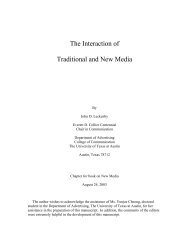“Do consumers want to design unique products on the internet? A ...
“Do consumers want to design unique products on the internet? A ...
“Do consumers want to design unique products on the internet? A ...
Create successful ePaper yourself
Turn your PDF publications into a flip-book with our unique Google optimized e-Paper software.
“The use of flexible process and organizati<strong>on</strong>al structures <str<strong>on</strong>g>to</str<strong>on</strong>g> produce varied and often<br />
individually cus<str<strong>on</strong>g>to</str<strong>on</strong>g>mized <str<strong>on</strong>g>products</str<strong>on</strong>g> and services at <strong>the</strong> low cost of a standardized, mass<br />
produced system.” (Hart 1995:1)<br />
The key difference in this sec<strong>on</strong>d definiti<strong>on</strong> is <strong>the</strong> idea of not promising <str<strong>on</strong>g>to</str<strong>on</strong>g> produce<br />
anything a cus<str<strong>on</strong>g>to</str<strong>on</strong>g>mer may desire but introducing flexibility, variety and where<br />
possible individualisati<strong>on</strong> <str<strong>on</strong>g>to</str<strong>on</strong>g> <strong>the</strong> experience. Note that this definiti<strong>on</strong> does suggest <strong>the</strong><br />
possibility <str<strong>on</strong>g>to</str<strong>on</strong>g> “maintain <strong>the</strong> efficiency of mass producti<strong>on</strong>” (Pine et al 1993; Piller<br />
2003). Research suggests that in most industries this is at present unrealistic, even<br />
with advances in manufacturing (such as CAD) and telecommunicati<strong>on</strong>s (e-<br />
commerce etc) technologies reducing <strong>the</strong> trade-off between variants and producti<strong>on</strong><br />
cost (Piller 2003) at present adding variety results in additi<strong>on</strong>al operati<strong>on</strong>al costs<br />
(Brabaz<strong>on</strong> and McCarthy 2004).<br />
Davis (1996) suggests that as technology advances markets become ever increasingly<br />
differentiated. The ultimate form of this differentiati<strong>on</strong> he suggests is <strong>the</strong> idea of<br />
“markets of <strong>on</strong>e”, where an individuals needs are met with mass efficiency.<br />
Definiti<strong>on</strong>s of MC in <strong>the</strong> academic literature have tended <str<strong>on</strong>g>to</str<strong>on</strong>g> overplay <strong>the</strong> need for MC<br />
<str<strong>on</strong>g>to</str<strong>on</strong>g> create a <str<strong>on</strong>g>unique</str<strong>on</strong>g> product or service. This paper rejects this and suggests that its<br />
cus<str<strong>on</strong>g>to</str<strong>on</strong>g>mer involvement that is <strong>the</strong> fundamental principal of MC (Piller et al 2004). The<br />
experience itself more than what is created provides <strong>the</strong> <str<strong>on</strong>g>unique</str<strong>on</strong>g> value for each<br />
individual (Prahalad and Ramaswamy 2004). The key differences between MC and<br />
MP are highlighted below in Table 1<br />
Adam Fletcher – Do <str<strong>on</strong>g>c<strong>on</strong>sumers</str<strong>on</strong>g> <str<strong>on</strong>g>want</str<strong>on</strong>g> <str<strong>on</strong>g>to</str<strong>on</strong>g> <str<strong>on</strong>g>design</str<strong>on</strong>g> <str<strong>on</strong>g>unique</str<strong>on</strong>g> product <strong>on</strong> <strong>the</strong> <strong>internet</strong>.<br />
2006<br />
14



